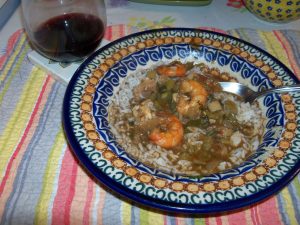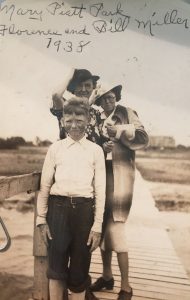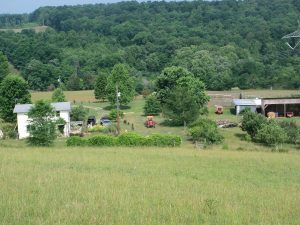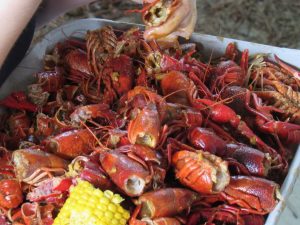
shrimp gumbo
The owner came from the back, out of the kitchen. “Boys, you are welcome to come look in the freezers,” he said, “but you have eaten everything in the place.” We eyed each other, stomachs more than sated, and noted the smug look on each other’s face. “Nope,” I said, “we are done.” Mission accomplished at the all-you-can-eat frog-leg buffet on the outskirts of Ruston, Louisiana, circa 1980. Lesson learned by the owner of the diner: You cannot compete with the appetite of a horde of 18-year-old males. If you offer it, they will descend like locusts and strip the foliage bare from the counters and the freezers.
Sometime around 2005, my father and I were touring some historic sites in the western parishes. After a morning on the battlefield of Mansfield, we stopped in Many for lunch. At a small cinder block restaurant on the outskirts of town, we ordered bowls of crawfish étouffée that were as good as any to be found. A glass of iced tea and a slice of pecan pie and we were back on the road. We spent the afternoon at Los Adaes, an old Spanish fort. When the French held Louisiana, the Spanish viceroy in Mexico City established this eastern outpost to stake a claim to the area.
One fall day, perhaps 1976, after visiting a construction site near Abbeville, Dad and I passed through the river town of Mermentau. There, we spotted a shell-covered parking lot packed at lunchtime with pickup trucks — in south Louisiana, a siren’s call to a gustatory feed. We slowed, found a spot, and got out. The menu was short. Nary a hamburger to be found, gumbo or catfish sauce piquante were the only options. We made our choice, paid, and moved to the other end of the counter to collect our bowls. Today’s lunch was the deep mahogany of a chicken-and-sausage gumbo. We took our place outside on long tables under the oaks, the oil roughnecks sliding over to make room for us.
Another day, this one in spring of 1984, I caught the ferry with friends and crossed the Mississippi to the historic town of Plaquemine. We stopped at a few random gas stations and bought a couple of pounds of homemade boudin at each. Boudin is a regional meal of rice, pork, and liver stuffed in natural hog casing. It is found throughout the southern part of the state, a perfect lunchtime repast, a meal-in-one that satisfies. We caught the ferry back across and spent the afternoon sitting on the levee eating our lunch and drinking Dixie beer before heading back to Baton Rouge.
This coming weekend I’ll be off the farm and back in the Deep South for the annual get-together of men in our family. We are staying in a lodge near Ville Platte, a town that used to be able to compete with all others for the quality of its boudin. We shall soon see if 2018 has brought any diminution to that reputation.
………………………………………………………………….
Reading this weekend: Payne Hollow (Hubbard) and Between Meals (Liebling)




